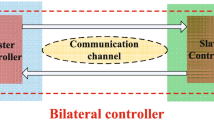Abstract
Among the prevalent methods in linear bilateral teleoperation systems with communication channel time delays is to employ position and velocity signals in the control scheme. Utilizing force signals in such controllers significantly improves performance and reduces tracking error. However, measuring force signals in such cases, is one of the major difficulties. In this paper, a control scheme with human and environment force signals for linear bilateral teleoperation is proposed. In order to eliminate the measurement of forces in the control scheme, a force estimation approach based on disturbance observers is applied. The proposed approach guarantees asymptotic estimation of constant forces, and estimation error would only be bounded for time-varying external forces. To cope with the variations in human and environment force, sliding mode control is implemented. The stability and transparency condition in the teleoperation system with the designed control scheme is derived from the absolute stability concept. The intended control scheme guarantees the stability of the teleoperation system in the presence of time-varying human and environment forces. Experimental results indicate that the proposed control scheme improves position tracking in free motion and in contact with the environment. The force estimation approach also appropriately estimates human and environment forces.











Similar content being viewed by others
References
Preusche C, Ortmaier T, Hirzinger G (2002) Teleoperation concepts in minimal invasive surgery. Control Eng Pract 10:1245–1250
Imaida T, Yokokohji Y, Doi T, Oda M, Yoshikava T (2004) Ground space bilateral teleoperation of ETS-VII robot arm by direct bilateral coupling. IEEE Trans Robot Autom 20:499–511
Lee D, Spong MW (2006) passive bilateral teleoperation with constant time delay. IEEE Trans Rob 22:269–281
Nuno E, Ortega R, Barabanov N, Basanez L (2008) A globally stable PD controller for bilateral teleoperators. IEEE Trans Rob 24:753–758
Hua, C, Yang Y (2011) Transparency performance improvement for bilateral teleoperation with direct force-feedback control. In: IEEE international symposium on haptic audio-visual environments and games, Proceeding, Qinhuangdao, Hebei, pp 62–67
Jafari A, Rezaei SM, Shiry Ghidary S, Zareinejad M, Baghestan K, Dehghan MR (2012) A stable perturbation estimator in force-reflecting passivity-based teleoperation. In: Transactions of the Institute of Measurement and Control, pp 1–10
Cho HC, Park JH (2005) Stable bilateral teleoperation under a time delay using a robust impedance control. Mechatronics 15:611–625
Danesh M, Sheikholeslam F, Keshmiri M (2005) External force disturbance rejection in robotic arms: an adaptive approach. IEICE Trans Fundam e88-A: 10
Chan L, Naghdy F, Stirling D (2013) Extended active observer for force estimation and disturbance rejection of robotic manipulators. Robot Auton Syst 61(12):1277–1287
Ahn HS (2010) Synchronization of teleoperation systems using state and force observer. In: International conference on control, automation and systems, Gyeonggi-do
Daly JM, Wang DWL (2009) Bilateral teleoperation using unknown input observers for force estimation. In: Proceeding of the American control conference, St. Luis, pp 89–95
Daly JM, Wang DWL (2010) Time-delayed bilateral teleoperation with force estimation for n-dof nonlinear robot manipulator. In: The 2010 IEEE/RSJ international conference on intelligent control and systems, Taipei, pp 3911–3918
Chen WH, Ballance DJ, Gawthrop PJ, O’Reilly J (2000) A nonlinear disturbance observer for robotic manipulator. IEEE Trans Ind Electron 47: 932–938
Mohammadi A, Marquez HJ, Tavakoli M (2011) Disturbance observer-based trajectory following control of nonlinear robotic manipulators. In: Proceedings of the 23rd CANCAM, Canada
Lichiardopol S, van de Wouw N, Kostic D, Nijmeijer H (2010) Trajectory tracking control for a tele-operation setup with disturbance estimation and compensation. In: Proceeding of the 49th IEEE conference on decision and control, Hilton Atlanta Hotel, Atlanta, GA, USA, December 15–17, 2010
Mohammadi A, Tavakoli M, Marquez HJ (2011) Disturbance observer-based control of nonlinear haptic teleoperation systems. IET Control Theory and Appl 5(18):2063–2074
Khalil HK (2002) Nonlinear systems, 3rd ed. Prentice Hall
Lu Z, Goldenberg AA (1995) A robust impedance control and force regulation: theory and experiments. Int J Robot Res 14:225–253
Haykin SS (1970) Active network theory. Addison-Wesley, Reading, MA
Hashtrudi-Zaad K, Salcudean SE (2001) Analysis of Control Architectures for Teleoperation Systems with Impedance/Admittance Master and Slave Manipulators. Int J Robot Res 20:419–445
Cho HC, Park JH, Kim K, Park JO (2001) Sliding-model-based impedance controller for bilateral teleoperation under varying time delay. In: Proceedings of IEEE international conference on robotics and automation, Korea, pp 1025–1030
Lawrence DA (1993) Stability and transparency in bilateral teleoperation. IEEE Trans Robot Autom 9:624–637
Zareinejad M, Rezaei SM, Abdullah A, Shiry Ghidary S (2009) Development of a piezo-actuated micro-teleoperation system for cell manipulation. Int J Med Robot Comput Asist Surg 5:66–76
Colgate J, Brown JM (1994) Factors affecting the Z-width of a haptic display. In: Proceedings of the IEEE international conference on robotics and automation, pp 3205–3210
Acknowledgments
The authors would like to acknowledge the University of Malaya for providing the necessary facilities and resources for this research. This research was funded by the University of Malaya Research Grant (UMRG) Program No. RP001C-13AET.
Author information
Authors and Affiliations
Corresponding author
Additional information
Technical Editor: Glauco A. de P. Caurin.
Appendix
Appendix
The hybrid matrix:
Rights and permissions
About this article
Cite this article
Amini, H., Dabbagh, V., Rezaei, S.M. et al. Robust control-based linear bilateral teleoperation system without force sensor. J Braz. Soc. Mech. Sci. Eng. 37, 579–587 (2015). https://doi.org/10.1007/s40430-014-0207-2
Received:
Accepted:
Published:
Issue Date:
DOI: https://doi.org/10.1007/s40430-014-0207-2



